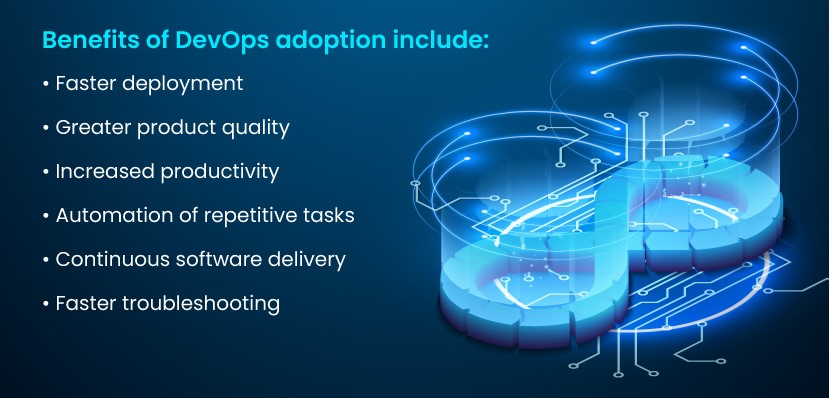Infrastructure in the Age of DevOps
A new era of IT is upon us. Gone are the days when development and operations worked in separate silos, leveraging independent processes, tooling, and goals. Businesses are increasingly turning to DevOps as a better organizational culture and methodology. By doing so, they seek to overcome counterproductive team rivalry and automate manual processes to accelerate software development lifecycles.
Why DevOps?
When it comes to enterprises, organizations are increasingly embracing DevOps principles to gain a competitive edge by delivering high-quality products to the market faster.
“During the pandemic, all the digital transformation accelerated, and DevOps was carried along with that. 13% of enterprises said they started new DevOps projects during lockdown, and other 28% said they accelerated projects that are already in progress.”
Craig Matsumoto, Senior Research Analyst at 451 Research
Behind the scenes, DevOps helps development and operations overlap and work together, addressing technical issues through pipelines, streamlining submission, testing, and revision of code. This blending of two separate philosophies and technologies into a collaborative tandem increases product quality and delivers more value to the customers. Development gets to focus on coding, while operations create the right production environment to ensure software quality and reduce lead times.

However, striving for more agility can leave organizations struggling with infrastructure-related challenges.
Finding DevOps-Friendly Infrastructure
DevOps and cloud-native tend to go together. With applications shifting from monolithic architectures to more agile and scalable ones, the infrastructure supporting them needs to follow the trend.
While traditional bare metal solutions offer advanced performance potential, they provide limited flexibility and often do not align with CI/CD pipelines. As a result, a growing number of organizations operate their application services in multi-cloud environments. This model brings:
- Automation support and ease of management.
- Fast resource provisioning.
- Scalability.
- No vendor lock-in.
While public cloud computing ticks many of the boxes on the DevOps-friendly list, security, cost management, compliance, and monitoring issues often hinder its full adoption.
This often leaves VPs of Engineering looking for infrastructure solutions that bridge the gap between flexibility and agility of cloud environments and the performance, security, and reliability of bare metal.
Bare Metal Cloud in the Age of DevOps
phoenixNAP’s Bare Metal Cloud (BMC) is an API-driven platform enabling automated provisioning and management of bare metal servers.
DevOps teams can use Bare Metal Cloud to scale their infrastructure through simple API calls, deploying and destroying instances in minutes. Also, they can leverage familiar, integrated IaC tools for automating their infrastructure management tasks.
Speaking of automation, BMC users gain access to actively maintained GitHub actions for streamlining the platform’s provisioning and creating CI/CD pipelines directly from GitHub.
When it comes to containerized workloads, BMC controller for K8s allows developers to define, deploy, and manage servers from within Kubernetes clusters. Additionally, BMC instances can be deployed with SUSE Rancher pre-installed, simplifying Kubernetes cluster management.
You can deploy servers with pre-installed Rancher software on Bare Metal Cloud in under 2 minutes.
Watch the video to learn how!
With no hypervisor overhead, BMC provides full access to its hardware resources, delivering high performance suitable for various use cases. Powered by the latest 3rd Generation Intel® Xeon® Scalable CPUs, BMC instances are built for data-intensive workloads such as virtualization, AI, ML, and high transaction databases.
Supporting the latest Intel Optane® Persistent Memory, BMC can bring large datasets closer to the CPU for unparalleled performance. With Intel SGX available in selected instances, BMC also enables confidential computing through hardware-level data encryption.
Overall, BMC presents an opex-modeled, orchestration-ready solution that delivers outstanding performance with cloud-like agility and flexibility. With pay-per-use and monthly reservation models, it is a scalable and cost-efficient platform for cloud-native applications and services.
"We are very much about orchestration and automation exposure to the bare metal cloud system that we have developed. From a ninja’s perspective, it’s the same type of technology they use for orchestration stacks, such as Ansible or Terraform. It makes it very easy for developers to take the resources they are already exposed to, make a couple of config line changes and go launch".
Ian McClarty, President of phoenixNAP
Opinions of the Experts
In a recent podcast with Craig Matsumoto, Senior Research Analyst at 451 Research, Ian McClarty, President of phoenixNAP, talked about DevOps and current trends in infrastructure consumption. Their conversation answers many questions related to modern IT, including:
- How DevOps helps organizations reach their key business objectives
- How Bare Metal ties to DevOps trends
- Where CPU and GPU industries are headed to
You can listen to the discussion here.